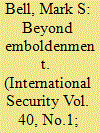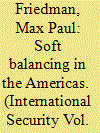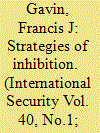|
|
|
Sort Order |
|
|
|
Items / Page
|
|
|
|
|
|
|
| Srl | Item |
| 1 |
ID:
140920


|
|
|
|
|
| Summary/Abstract |
Fortified boundaries are asymmetrical, physical barriers placed along borders. These boundaries are more formidable in structure than conventional boundary lines, but less robust than militarized boundaries. Their goal is to impose costs on infiltrators and in so doing deter or impede infiltration. A novel dataset of all such boundaries worldwide shows that states are constructing these barriers at an accelerating rate. More than half of barrier builders are Muslim-majority states, and so are the vast majority of targets. A multivariate analysis demonstrates that, contrary to conventional wisdom, states that construct such barriers do not tend to suffer disproportionately from terrorism, nor are they apt to be involved in a significant number of territorial disputes. Instead, differences in state wealth and migration rates are the best predictors of barrier construction. Qualitative case studies suggest that the most effective fortified boundaries are found where the initiating state controls the territory beyond a boundary that blocks the only access route into the state.
|
|
|
|
|
|
|
|
|
|
|
|
|
|
|
|
| 2 |
ID:
140918


|
|
|
|
|
| Summary/Abstract |
What happens to the foreign policies of states when they acquire nuclear weapons? Despite its importance, this question has not been answered satisfactorily. Nuclear weapons can facilitate six conceptually distinct foreign policy behaviors: aggression, expansion, independence, bolstering, steadfastness, and compromise. This typology of foreign policy behaviors enables scholars to move beyond simple claims of “nuclear emboldenment,” and allows for more nuanced examination of the ways in which nuclear weapons affect the foreign policies of current and future nuclear states. The typology also sheds light on Great Britain's response to nuclear acquisition. Britain used nuclear weapons to engage in greater levels of steadfastness in responding to challenges, bolstering junior allies, and demonstrating independence from the United States, but it did not engage in greater levels of aggression, expansion, or compromise. The typology and the British case demonstrate the value of distinguishing among different effects of nuclear weapons acquisition, have implications for scholars' and policymakers' understanding of the role of nuclear weapons in international politics, and suggest avenues for future research.
|
|
|
|
|
|
|
|
|
|
|
|
|
|
|
|
| 3 |
ID:
140916


|
|
|
|
|
| Summary/Abstract |
How has the United States behaved historically toward friendly states with nuclear weapons ambitions? Recent scholarship has demonstrated the great lengths to which the United States went to prevent Taiwan, South Korea, and West Germany from acquiring nuclear weapons. Yet seemingly on the other side of the ledger are cases such as Israel, South Africa, and Pakistan, where the United States failed to prevent proliferation, and where many have argued that the United States made exceptions to its nonproliferation objectives given conflicting geopolitical goals. A reexamination of the history of U.S. nonproliferation policy toward Israel, South Africa, and Pakistan, based on declassified documents and interviews, finds that these cases are not as exceptional as is commonly understood. In each case, the United States sought to prevent these states from acquiring nuclear weapons, despite geopolitical constraints. Moreover, once U.S. policymakers realized that prior efforts had failed, they continued to pursue nonproliferation objectives, brokering deals to prevent nuclear tests, public declaration of capabilities, weaponization, or transfer of nuclear materials to other states.
|
|
|
|
|
|
|
|
|
|
|
|
|
|
|
|
| 4 |
ID:
140919


|
|
|
|
|
| Summary/Abstract |
In the aftermath of the 2003 U.S.-led invasion of Iraq, scholars of international relations debated how to best characterize the rising tide of global opposition. The concept of “soft balancing” emerged as an influential, though contested, explanation of a new phenomenon in a unipolar world: states seeking to constrain the ability of the United States to deploy military force by using multinational organizations, international law, and coalition building. Soft balancing can also be observed in regional unipolar systems. Multinational archival research reveals how Argentina, Mexico, and other Latin American countries responded to expanding U.S. power and military assertiveness in the early twentieth century through coordinated diplomatic maneuvering that provides a strong example of soft balancing. Examination of this earlier case makes an empirical contribution to the emerging soft-balancing literature and suggests that soft balancing need not lead to hard balancing or open conflict.
|
|
|
|
|
|
|
|
|
|
|
|
|
|
|
|
| 5 |
ID:
140915


|
|
|
|
|
| Summary/Abstract |
The United States has gone to extraordinary lengths since the beginning of the nuclear age to inhibit—that is, to slow, halt, and reverse—the spread of nuclear weapons and, when unsuccessful, to mitigate the consequences. To accomplish this end, the United States has developed and implemented a wide range of tools, applied in a variety of combinations. These “strategies of inhibition” employ different policies rarely seen as connected to one another, from treaties and norms to alliances and security guarantees, to sanctions and preventive military action. The United States has applied these measures to friend and foe alike, often regardless of political orientation, economic system, or alliance status, to secure protection from nuclear attack and maintain freedom of action. Collectively, these linked strategies of inhibition have been an independent and driving feature of U.S. national security policy for more than seven decades, to an extent rarely documented or fully understood. The strategies of inhibition make sense of puzzles that neither containment nor openness strategies can explain, while providing critical insights into post–World War II history, theory, the causes of nuclear proliferation, and debates over the past, present, and future trajectory of U.S. grand strategy.
|
|
|
|
|
|
|
|
|
|
|
|
|
|
|
|
|
|
|
|
|